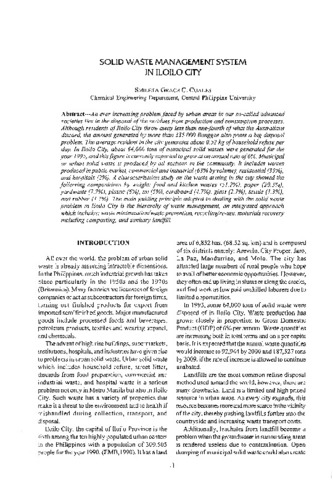Solid waste management system in Iloilo City
Abstract
An ever increasing problem faced by urban areas in our so-called advanced societies lies in the disposal of the residues from production and consumption processes. Although residents of Iloilo City throw away less than one-fourth of what the Australians discard, the amount generated by more than 335,000 Ilonggos also poses a big disposal problem. The average resident in the city generates about 0.52 kg of household refuse per day. In Iloilo City, about 64,000 tons of municipal solid wastes were generated for the year 1995, and this figure is currently expected to grow at an annual rate of 6%. Municipal or urban solid waste is produced by all sections in the community. It includes wastes produced in public market, commercial and industrial (63% by volume), residential (35%), and hospitals (2%). A characterization study on the waste arising in the city showed the following compositions by weight: food and kitchen wastes (51.2%), paper (20.3%), yardwaste (7.7%), plastic (6%), tin (5%), cardboard (4.7%), glass (2.7%), textile (1.3%), and rubber (1.1%). The main guiding principle adopted to dealing with the solid waste problem in Iloilo City is the hierarchy of waste management, an integrated approach which includes: waste minimization/waste prevention, recycling/re-use, materials recovery including composting, and sanitary landfill.
Description
Journal article
Suggested Citation
Cuales, S. G. C. (1996). Solid waste management system in Iloilo City.Type
ArticleSubject(s)
Keywords
Collections
- Engineering Journal [23]



